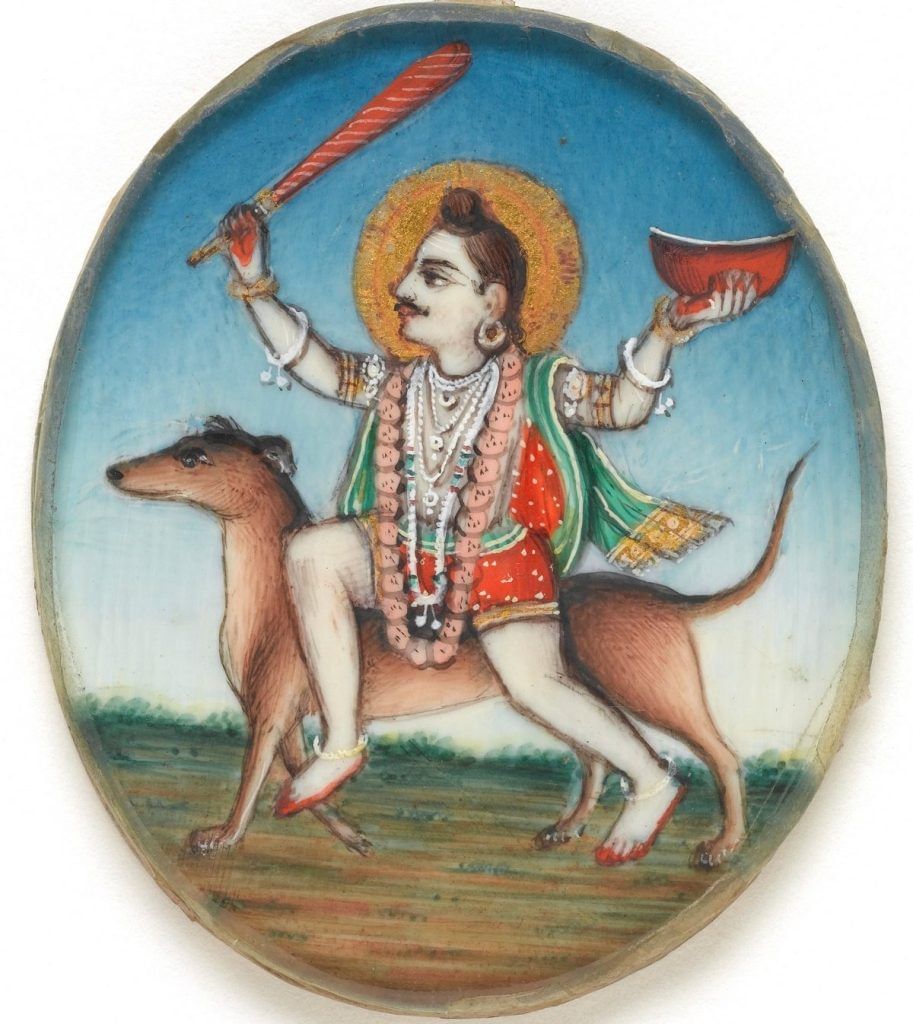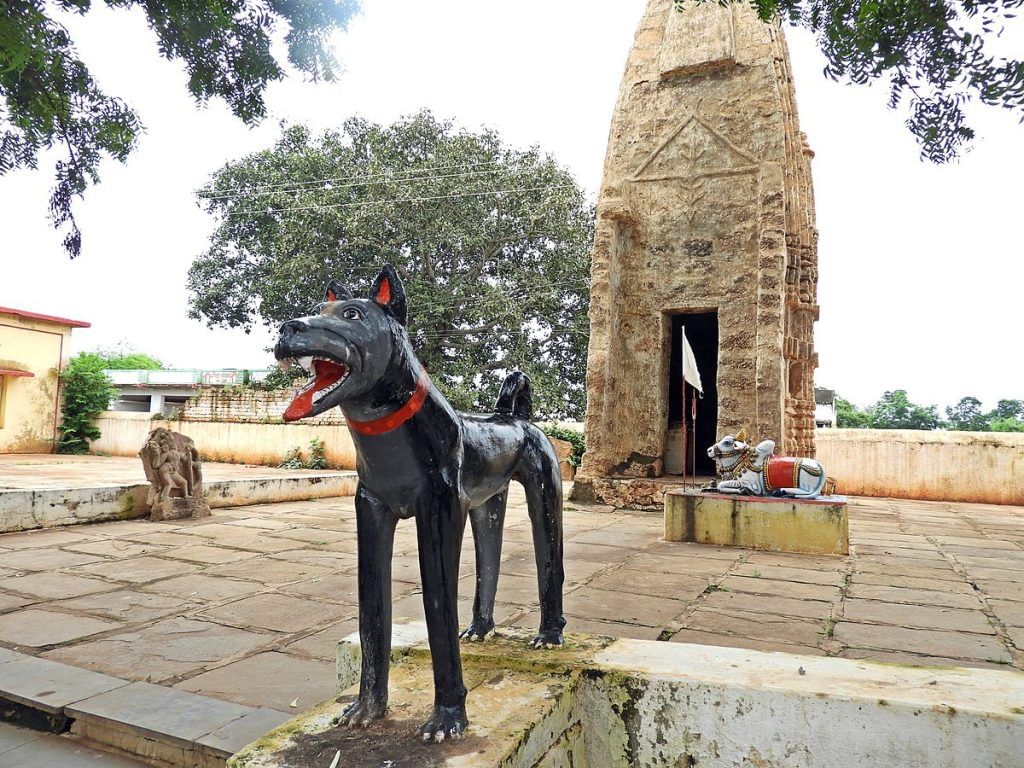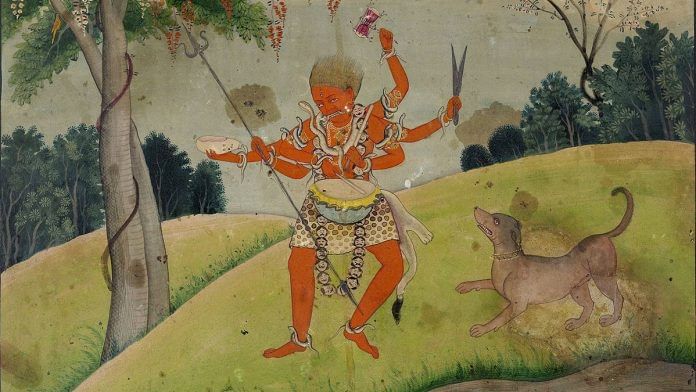The past few days have left many of us quite perplexed, with ‘man versus dog’ sentiments raging on news channels and other media. It set one thinking about the contradictions between our professed beliefs and religiosity, carried on our sleeve—as also wrists, foreheads, and what have you—and the loss of civilisational virtues in the times we live in.
In our ancient traditions, dogs walk with gods and heroes.
For instance, the month of Shravan is celebrated by Shaivites with great fanfare, through fasts, rituals, pilgrimages, and by procuring waters from the holy Ganga for offerings in local temples. Shiva, the lord of the cremation ground and the conqueror of Kala (death and time), first known as the roaring archer Rudra, is given the title Pashupati in the Vedas by Prajapati. As Pashupati, he is lord of the animals: antelopes, buffaloes, camels, asses, those beings in the air, and both wild (forest) and tame (village) creatures.
Shiva is also worshipped as Bhairava, signifying the frightening and terrible aspect of the divine. It is in this form that he is associated with the dog, generally shown as his companion, and sometimes rendered as his emblematic vehicle (vahana).
There are numerous sculptures and bronzes from South India that depict Bhairava in his mendicant form, called Bhiksantar or Picchandar, bearing a skull-cup with a shvan (dog) behind him.
Shilpa texts such as Rupamala and Rupamandana mention Vatuka Bhairava as riding on a black dog. Medieval and early modern paintings from Mandi, Mewar, and elsewhere show the dog prominently in Bhairava depictions, including one where Bhairava is carrying a dog on his back.
But this association is not confined to just texts and myths; it is known in lived religion as well.
Also Read: Delhi’s war on dogs has turned RWAs into a battleground. ‘They’re fighting, not debating’
A faithful companion, Mahabharata to Naladiyar
More than a decade ago, while on fieldwork in the Kolhua hills in Chotanagpur, a black dog suddenly appeared as we were climbing up the hill. A baba who lived in a kutir at the foothill commented that Bhairon Baba had come to escort me. Later, a snake crossed my path, and I was told I was doubly blessed by Shivji.
This is the popular imagery of the god, drawn from a civilisational understanding of the harmony between humans and animals. And yet, we stand today at a juncture where the peripheral and the superficial are conspicuous, but the seeking of truth and higher consciousness through religion—embodied in such an understanding of living with nature and fellow beings—stands eroded, at least in some circles.

The most abiding story about dogs centres around their faithfulness and devotion, and comes from the Mahabharata.
After the great war, following the devastation and the claiming of the patrimony by the Pandavas, Yudhishtira informed his brothers and wife that the time had come to abandon worldly and indeed earthly life. Led by him, they embarked on the mahaprasthana, the great end to life’s journey. The five brothers, Draupadi, and a dog traversed the eastern, southern, and western dominions before heading north toward the Himalayas.
As they proceeded on the final leg up the great mountain, one after another all the companions of Yudhishtira, save the dog, fell due to their karmas. Finally, Indra approached the epitome of dharma, Yudhishtira, inviting him to enter his celestial chariot so he could be transported to the heavens. When told there was no place for the dog—neither in the chariot nor in the devaloka—Yudhishtira made the profound statement that the abandonment of one who is faithful is a mahapataka, the greatest sin, and that he would refuse a place in heaven rather than commit it.
There are instances of dogs being commemorated as companions in historical records and burials. An evocative example comes from Pallava times, where the dog Kovivan went down fighting bravely alongside his master Karundevakathi when they encountered cattle thieves. There are similar examples from other parts of South India as well.
The Naladiyar, a famous early Tamil poetic work, conveys the loyalty and love shown by the dog in a verse that says even if a spear is thrown at it by its master, it will wag its tail and look up at him.
Also Read: Maria Gomes feeds over 300 stray dogs. She challenges the popular image of a dog lover
Dogs and dharma
The recent court order seeking the rounding up of this companion of humans over millennia is a sad story of our times, where our civilisational values of fellowship and cohabitation have been obscured by our frenzied pursuits in modern life. This has clearly affected community animals such as dogs, who have been marginalised, feared, beaten, and/or driven away from our ‘gated’ residential areas, with no empathy for their well-being or even their existence.
Growing up in Hyderabad, with family in Chennai and other places down south, dogs on the road were a ubiquitous presence, with the local tea-stall aunty keeping a bowl of rice or tossing biscuits and other scraps down for them. One didn’t go out of one’s way to pet them or be friendly at that time. My own proximity to them, despite many friends having dogs, was a COVID development, when my children took in an abandoned dog. For almost a year, Golu would sit at our door staring out with sad eyes, probably hoping to see her earlier family.

The losses we saw during those terrible times—family, friends, and students taken by the dreaded virus—were shared by Golu. Each time one of us cried, he would nuzzle against us, place his paws on our shoulders, comfort us. Frankly, I saw myself as learning empathy and love from him.
This does not, of course, take away from the real fears associated with dog bites and disease. But those risks must be addressed without fear-mongering or cruelty.
In a letter, Sigmund Freud stated that dogs have a clear-cut understanding of who their friends and enemies are, unlike humans, who can love and hate a person at the same time.
My children have been bitten by dogs, but each time they have shown great maturity and sensitivity, trying to understand the problem—whether the dog felt threatened, or whether it was an accidental occurrence triggered by something. The solution to the problem of dog bites is to create greater community awareness, and to resurrect the empathy and civilisational bonds that our stories about gods and heroes, and our historical records, offer us.
By removing dogs from communities, we are condemning them to disease and death.
As Yudhishtira so beautifully said, abandoning someone devoted to you is a bottomless evil. The domesticated dog is our creation; it is incumbent upon us to nurture and protect it. By extending support through feeding and care, by vaccinating and sterilising dogs, we perform our dharma toward them, as the times require us to. Equally important, we need to create wider community bonds, so that children and adults do not fear these beautiful creatures, who are as much our creations as they are of the gods.
Dr R Mahalakshmi is a professor at the Centre for Historical Studies, Jawaharlal Nehru University. Views are personal.
(Edited by Asavari Singh)





What does any of this history or geography have to do with stray dogs multiplying out if control, biting people and causing havoc on the streets? No one is banning dogs. You are welcome to agitate and push for better shelters and spay/neutering work and treating the remaining dogs humanely. This emotional blackmail is useless and a privilege of if the upper class who drive past the street dogs and occasionally run them over
Dilemma of social justice warriors regarding _Dharma_ : choice between dog and Eklavya
Verses 19 and 20, chapter 123 of _Adi Parva, Mahabharata_ (critical edition) tells us that when the dog lover Pandavas encountered Eklavya the Shudra tribal boy for the first time, Pandava’s dog was shot by 7 arrows in its mouth by Eklavya. We don’t know if that dog sustained the injuries or died (which he probably did) . The moral dilemma of social justice warriors should be of choosing between the young tribal boy who was denied education by a cruel casteist Brahmana and the poor innocent dog of Yudhishthira. As mentioned in the article, Yudhishthira was extremely fond of dogs. Now the SJW need to decide which side to take – between the dog who is the ultimate symbol of _Dharma_ , or the oppressed tribal boy who is killing this symbol of _Dharma_.
Of course it is your civilisational ethos. In pursuance of such ethos, please adopt all stray dogs. Else, fund the construction of massive dog shelters where you can care for them.
Why should the entire civilization suffer due to the ethos of a few? That’s gross gross injustice.
Thank you Prof. R. Mahalakshmi for bringing out the historical connection with dogs, apart from cows who are popularised more as a sacred in religious domain. Many conceptions are there about dog that has framed them negatively causing ritual impurity. Your personal story about Golu is heartwhelming which many of us pet-lovers particularly dog livers can relate to. I hope this article gets widely circulated and brings out new perspective about how people treat dogs. judicial judgement has shown how human-made social hierarchies and it’s prejudices are imposed on animals. It’s human who is deciding over who can be pet and who are left on streets. Discrimination in treatment can be noticed easily. I hope every dogs, regardless of their breed should be loved and taken care of because getting bites either from strays which people love to refer street dogs or from homely ones are to be treated equally. Love to read your article with many historical evidences.